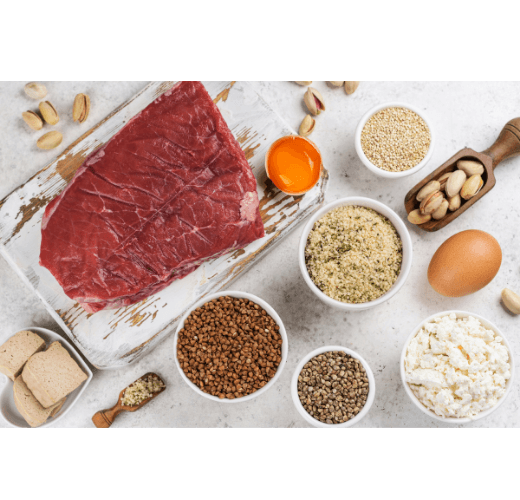
SPORTS NUTRITION PART 1 MACRO’S - PROTEIN
A Brief Overview of Macro’s to help understand how they relate to the energy systems used by the body.
In nutrition, “Macros” refer to the major nutrients our bodies use;
Protein, Carbohydrates, Fats, Fibre and Water.PROTEINS
Protein is absolutely essential to life. Without it, we will die because protein is involved in literally every process within our body from the production of enzymes, digestion, cell repair, cell growth, mental function, and correct function of our immune system, just to name a few.
Protein comes in many forms, and in nature it is usually found with one or two of the other macros, for example, meats like chicken, beef or fish are protein plus fats. Dairy products such as yoghurt or milk are protein plus fat plus carbs. Plant proteins such as chickpeas or beans are protein plus carbs, plus fats plus fibre.
Proteins can also be isolated into products like egg white, whey protein isolate, calcium caseiante all of which are virtually pure protein. It used to be that protein powders on the market were very high protein, containing nearly 90% protein, but the trend now is to reduce the protein content of protein powder to keep the price low, so always read the label when purchasing to see what other macros you are getting.
Regardless of the type of protein, all proteins are made up of amino acids. Every different food has a different sequence of amino acids. Our body needs 20 different amino acids, but 9 of those we cannot synthesize ourselves. So we need to consume those in our foods. And that's what we all know as the essential amino acids.
ISOLEUCINE, LEUCINE & VALINE are Branch Chain Amino Acids (BCAA’s), and also part of the group of Essential Amino Acids (EAA’s). The other 6 EAA’s are; Histidine, Lysine, Methionine, Phenylalanine, Threonine and Tryptophan.
The good news, especially for vegans and people on plant based diets is that the body doesn't have to get all the essential amino acids at one time. As long as you're not deficient in one or more of those essential amino acids for an extended number of days, your body can utilize the protein for growth, repair and correct function, otherwise it will be burnt for fuel as either glucose or ketones.
Of those 20 amino acids used by our bodies, it's only leucine and lysine that can't be turned into glucose. Leucine and Lysine must be turned into ketone bodies and used through the ketogenic energy system.
Alanine, Glycine, Cysteine, Serine, Arginine, Histidine, Proline, Glutamine, Methionine, Aspartic Acid and Valine can only be turned into glucose, these are the gluconeogenic amino acids, used through the gluconeogenic pathway.
The remaining amino acids, Threonine, Tryptophan, Tyrosine, Phenylalanine and Iso-leucine can go through either the ketogenic cycle or they can go through the gluconeogenic cycle and be used in either way.
This does become important when you're looking at energy systems, but just note that it's leucine, which is obviously very, very familiar with everybody, because of its role in muscle growth, and lysine, that are the only two that can't be converted to be burned as glucose.
What are some of the main sources of protein for bodybuilders?
You can't go past chicken (chicken breast), beef, and I will say the lean versions of all of these, because as a bodybuilder, I tend to only look at the lean versions. I would only recommend chicken breasts, lean 90% fat-free steak, Fish, which is quite lean, although, as with animal proteins, they can also be a source of fat, depending on the type of fish used. Deep sea fish tend to be fatter than white fish, however the fats are very healthy. Chicken, meat and fish are not a source of carbohydrate, but they generally do have some source of fat with them, so you need to take that into account when you're looking at your overall diet and where your energy is coming from.
A good protein powder is probably one of the few proteins which is virtually all protein, but now days you do have to be careful when choosing a protein powder because a lot contain high levels of carbs and some fats. When we started International Protein, the market demanded that protein supplements had to have a very high protein content. If your product wasn't over about 85% protein coming from a whey protein isolate, people really wouldn't look at it, but now, I see a lot of proteins down in the 60%, maybe 70%. Always take the time to check out the Nutrition Panel and ingredients lists on any protein powder before you buy so you are aware of where it will fit in your nutrition plan.
International Proteins Amino Charged WPI contains a massive 35g protein per 40g serve which is about 88% protein! One of the highest on the market! It’s incredibly high in all the Essential Amino’s acids, especially the Branch Chain Amino Acids and contains extra Glutamine and Arginine for post workout recovery. It’s also super low in lactose so even those with lactose intolerance can use this amazing product.



